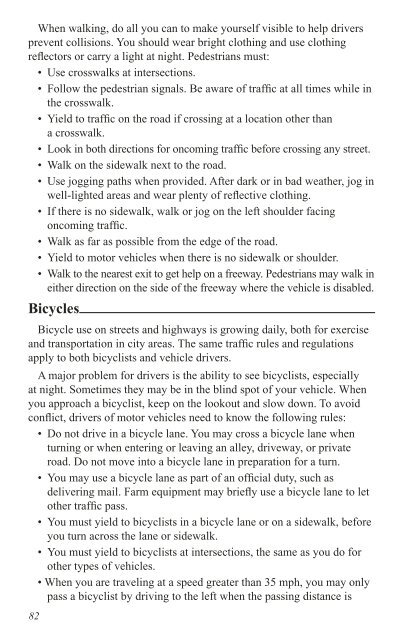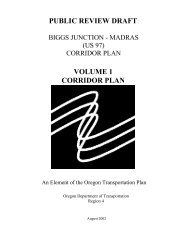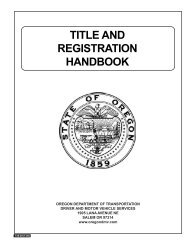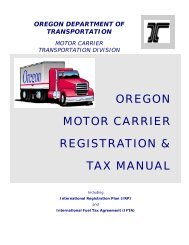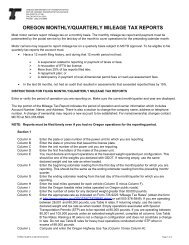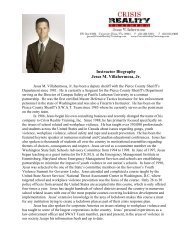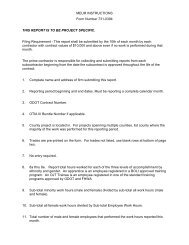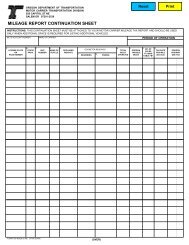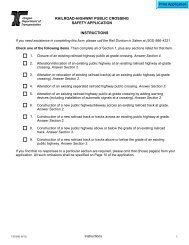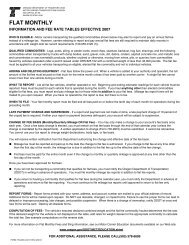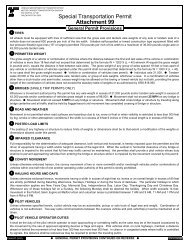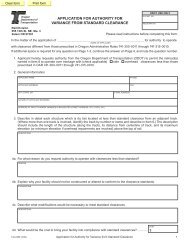2013 Oregon Driver Manual - Oregon Department of Transportation
2013 Oregon Driver Manual - Oregon Department of Transportation
2013 Oregon Driver Manual - Oregon Department of Transportation
Create successful ePaper yourself
Turn your PDF publications into a flip-book with our unique Google optimized e-Paper software.
When walking, do all you can to make yourself visible to help drivers<br />
prevent collisions. You should wear bright clothing and use clothing<br />
refl ectors or carry a light at night. Pedestrians must:<br />
• Use crosswalks at intersections.<br />
• Follow the pedestrian signals. Be aware <strong>of</strong> traffi c at all times while in<br />
the crosswalk.<br />
• Yield to traffi c on the road if crossing at a location other than<br />
a crosswalk.<br />
• Look in both directions for oncoming traffi c before crossing any street.<br />
• Walk on the sidewalk next to the road.<br />
• Use jogging paths when provided. After dark or in bad weather, jog in<br />
well-lighted areas and wear plenty <strong>of</strong> refl ective clothing.<br />
• If there is no sidewalk, walk or jog on the left shoulder facing<br />
oncoming traffi c.<br />
• Walk as far as possible from the edge <strong>of</strong> the road.<br />
• Yield to motor vehicles when there is no sidewalk or shoulder.<br />
• Walk to the nearest exit to get help on a freeway. Pedestrians may walk in<br />
either direction on the side <strong>of</strong> the freeway where the vehicle is disabled.<br />
Bicycles<br />
Bicycle use on streets and highways is growing daily, both for exercise<br />
and transportation in city areas. The same traffi c rules and regulations<br />
apply to both bicyclists and vehicle drivers.<br />
A major problem for drivers is the ability to see bicyclists, especially<br />
at night. Sometimes they may be in the blind spot <strong>of</strong> your vehicle. When<br />
you approach a bicyclist, keep on the lookout and slow down. To avoid<br />
confl ict, drivers <strong>of</strong> motor vehicles need to know the following rules:<br />
• Do not drive in a bicycle lane. You may cross a bicycle lane when<br />
turning or when entering or leaving an alley, driveway, or private<br />
road. Do not move into a bicycle lane in preparation for a turn.<br />
• You may use a bicycle lane as part <strong>of</strong> an <strong>of</strong>fi cial duty, such as<br />
delivering mail. Farm equipment may briefl y use a bicycle lane to let<br />
other traffi c pass.<br />
• You must yield to bicyclists in a bicycle lane or on a sidewalk, before<br />
you turn across the lane or sidewalk.<br />
• You must yield to bicyclists at intersections, the same as you do for<br />
other types <strong>of</strong> vehicles.<br />
• When you are traveling at a speed greater than 35 mph, you may only<br />
pass a bicyclist by driving to the left when the passing distance is<br />
82


